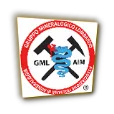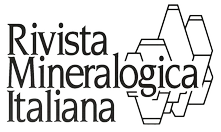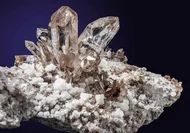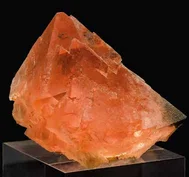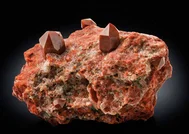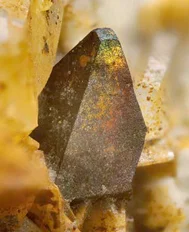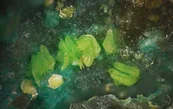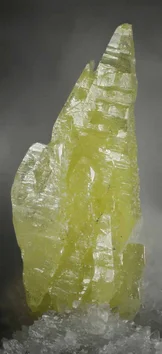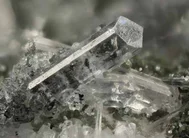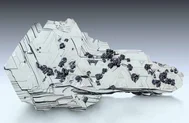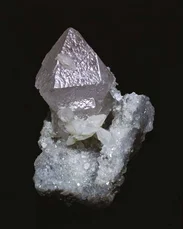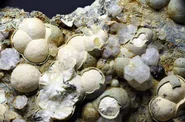Abstract 2022
Rivista Mineralogica Italiana > Abstract Articoli
Abstract ITALIAN MINERALOGICAL MAGAZINE nr. 1-2022 | ||||||
MONTE BIANCO MINERALS, ENVIRONMENTS, ITINERARIES |
| |||||
Notes for mineralogical research on Mont Blanc
| ||||||
THE FRENCH VERSANT | Location in the western sector
| |||||
Abstrat ITALIAN MINERALOGICAL MAGAZINE nr. 2-2022 | ||||||
Since ancient times, the hematoid quartz variety called “Jacinto de Compostela” is one of the most renowned minerals in the Spanish mineralogical tradition. This variety of quartz was called “Jacinto de Compostela” by the pilgrims traveling to Santiago de Compostela: they called it “jacinto”, that is hyacinth, because of the resemblance to the flower’s color. These quartz crystals formed within the evaporitic rocks characterizing the lithostratigraphic unit of the Keuper, Triassic in age (210-200 million years ago). The Compostela quartz can be defined authigenic because is hosted within the evaporitic rocks where it was formed. The “Jacinto de Compostela” quartz forms complete biterminated individuals, very rarely exceeding 4 cm in length, but showing a great variety of colors (red, brown, orange, yellow, milky) and shapes (single crystals, druses, groups and clusters with different levels of compenetration). The peculiar tonality of this crystals is mainly due to hematite inclusions. The erosion caused by the rains ensures a continous renewal of the material exposed from the Keuper formation, being composed by gypsum, clay, and other soft sedimentary rocks. For such reason, nice findings of “Jacinto de Compostela” quartz are always possible in most of the mentioned localities. | ||||||
Stintino peninsula is located in the northwest of Sardinia. It is characterized by the Palaeozoic units of the Variscan metamorphic basement crosscut by quartz veins. At Cala Coscia di Donna, anatase crystals up to 1 mm, brown-reddish and rarely green were found within quartz veins. Furthermore, in the area located between Cala Coscia di Donna and Torre del Falcone, other minerals occur and include: albite, almandine, “chlorite”, ilmenite, muscovite, “ironoxides and hydroxides”, pyrite, quartz and “tourmaline”. | ||||||
HYDROXYLGUGIAITE FROM ALPE ROSSO: A PREVIOUS WRONG IDENTIFICATION OF MELIPHANITE | During a characterization work of beryllium minerals occurring at various locations in the Alps, few samples of Alpe Rosso "melinophane” were analyzed and they turned out to hydroxylgugiaite, a decidedly rarer mineral, approved only in 2017 as a new species on samples from Norway and Greenland. The identification of hydroxylgugiaite took place through Raman spectrometry,X-ray diffraction from single crystal and EDS mode analysis, not excluding that gugiaite may also occur at Alpe Rosso. | IDROCERUSSITE URANIUM RICH FROM THE MINING SITE Of MONDAGIÒ (VALLE DI CEMBRA, GIOVO, TN) | We report here the description of a variety of uranium-rich hydrocerussite, found on the roof of the porphyrites of the Atesino Volcanic Group (Lower Permian) at the ancient silver-bearing occurrence of the Mondagiò mining area (Giovo, Valle di Cembra, Trento). The EDS analyses showed the presence of significant quantities of uranium and the structural refinement shows a partial replacement of the Pb2+ ion by the uranyl ion UO22+ which is reflected in an increase in the unit-cell c parameter. | |||
PROSOPITE FROM THE CAVALLIZZA MINE, CAVAGNANO, CUASSO AL MONTE (VA) | Since 2010 several studies were carried on at the Cavallizza mine, the type locality for chukhrovite-(Ca), in order to evaluate the presence of other halides. The studies have led to the identification of prosopite, an uncommon calcium and aluminium oxyfluoride, occurring as white aggregates, up to 1 mm across, composed by tabular crystals. | |||||
FINDINGS AT COPPER CAVE - MINE OF "CAPO CALAMITA" | Native copper, sometimes in association with cuprite, from the site called “Grotta Rame” in the Vallone stope, in the Capo Calamita mine, represents one of the most desirable classics of Elban mineralogy. Although the copper samples from this locality are generally of modest or relatively modest size (rarely reaching 10 cm in diameter), these stand out for the exceptional quality of the crystallizations in terms of definition of crystalline forms, luster and, sometimes, by color (almostred due to the presence of a veil of cuprite). However, information about this locality in the Elban literature is scarce and fragmentary. This article summarizes a series of information collected by the authors and also the testimonies on the locality by Renzo Casagrande, a Tuscan collector who, together with his family, frequented this area assiduously in the 1970s. Today the site is covered with mine dumps and is no longer accessible to collectors. | |||||
Abstract ITALIAN MINERALOGICAL MAGAZINE nr. 3-2022 | ||||||
An old specimen of sulfur from the Monti Livornesi area is kept in the mineralogical collections of the Museo di Storia Naturale of the Università di Pisa and shows the presence of bi-pyramidal crystals, up to 3 cm in size, grown on calcite. This unusual specimen promoted the study described in this paper. Indeed, the occurrence of sulfur has been known from Leghorn since the mid-19th century, where it was described by some authors from the Monte Tignoso quarries, near Ardenza, in the southern part of Leg horn. Since then, no modern findings were reported until 2011, when one of us (F.S.) discovered sulfur crystals in the eastern sector of the Monti Livornesi, close to the hamlet of Parrana San Martino. The original finding was performed in a rock sample found along the Botro Caldo, a small river located to the north of the small village of Pietre to. Unfortunately, the actual outcrop of this rock was not found. Recently, new mineralogical and geological surveys in this sector of the Monti Livornesi allowed to find further specimens in the Podere Sant’Anna and Cordecimo areas. In all these localities, a peculiar kind of rock, formed by carbonated gypsum, occur. Gypsum, sometimes in the typical swallowtail twins, is completely replaced by calcite, forming a travertine-like rock; in some vugs, well-developed sulfur crystals, up to 1 cm in size, have been observed. Crystal habit is usually bipyramidal, even if tabular or prismatic crystals have been collected. Associated minerals are calcite, in scalenohedral colorless crystals up to 2 mm in length, and rarely pyrite as very small octahedra usually grown on sulfur. Mammillary aggregates of pyrite, up to 3 mm across, have been also found. The occurrence of sulfur in the Monti Livornesi area and its association with some peculiar rocks (carbonated evaporites) deserves further geological studies. | ||||||
The Calabrian-Peloritani Arc is a poorly studied area from a mineralogical perspective. Its current geological setting is the result of two different orogenic events, i.e., the Variscan and Alpine orogenies. Recent mineralogical researches allowed the finding of nice almandine crystals. More recently, in 2018, the possible occurrence of cordierite was noted by one of us (GB) during the paving of a road to the Santa Maria del Patire Abbey, close to the villages of Corigliano and Rossano Calabro, in the Cosenza Province. Further investigations allowed to localize the source of the stones used for the paving of the road, i.e., the Cava di Melis, located in the Longobucco municipality. Cordierite occurs as euhedral prismatic crystals, up to 3 cm in length and 1 cm across. The habit is prismatic, with wide basal pinacoids. Color ranges from light to dark green, sometimes with brownish hues. Some crystals are more or less altered in “pinite”. Cordierite is hosted in a microgranite dike cutting an altered granodiorite. Electron microprobe analysis confirmed that magnesium is dominant over iron. In addition to cordierite, other minerals found in this kind of occurrence are quartz, in bipyramidal phenocrysts, and rare pyrite crystals superficially altered in limonite. | ||||||
MULLITE RICH IN ALUMINUM AND COPPERER: AN INTERESTING NOVELTY FROM MOUNT CERVANDON | The mullite of Mount Cervandone has very different morphological characteristics compared to the usual mullite as it forms thin encrustations, very pale sky blue-greenish in color, lying on vitreous quartz. | |||||
This article re-proposes the historic and unique exceptional discovery of phenakite in the Beura quarries. It is the only discovery made in 1969 by F. Cantadore in very few specimens showing many crystals up to several millimeters in length. The uniqueness of the find is given by the quality of these samples since in Italy phenakite has never been found in relatively large specimens. At Beura two generations of phenakite crystals were observed: the first ones reach up to about two millimeters, have short prismatic habit consisting of hexagonal prisms terminated by well-developed rhombohedron faces whereas the second generation occur in elongated hexagonal prisms, whose dimensions reach up to several millimeters in length. | ||||||
HEMATITE FROM MONTE CALVARIO, BIANCAVILLA (SICILY) | Many and beautiful specimens of hematite, as shiny tabular crystals have been known since the 19th century from the Monte Calvario quarry, near the town of Biancavilla (Sicily). These specimens are the best ever found in the Mt. Etna volcanic complex and can be considered among the classic mineral specimens from Sicily. At the end of the 20th century, the termination of the quarrying activity and the following environmental remediation precluded the collection of further important specimens of hematite. | |||||
This short note describes nice “iron roses” of hematite up to 2 centimeters in size collected in the Cairasca valley, within alpine-type fissures in erratic boulders occurring on the slopes located just north of the Varzo village. | ||||||
Abstract ITALIAN MINERALOGICAL MAGAZINE nr. 4-2022 | ||||||
The two authors, exploring Mount Tamara slopes, near Nuxis village in South Sardinia, were able to find a secondary entrance to the abandoned San Pietro Mine. A long and accurate exploration of mine shafts and galleries brought them to the exeptional discovery of large (for the locality), shining and perfect crystals of scheelite. The scheelite identifcation was confirmed by SEM-EDS analysis. | ||||||
TEOFILO SANTINI (1918-2018) AN ITALIAN EXCELLENCE IN MINERALOGICAL COLLECTING  | Eng. Teofilo Santini (1918-2018) from La Spezia (Italy), in his long life, has established one of the most important Italian mineralogical collections. In the second half of the 1960s, he had the good opportunity to buy some of the best specimens previously belonging to the well-known Magistretti Collection. In the following decades, Teofilo Santini dedicated himself to buying Italian and foreign aesthetic samples, with a particular preference for red minerals, especially rhodochrosite. Teofilo Santini was born in Tirano (SO), on June 1,1918. After his high school studies, he graduated in Industrial Chemical Engineering at the University of Genoa. | |||||
NEW ITALIAN MINERAL SPECIES | Three new mineral species having an Italian type locality have been approved in 2021. They were discovered in Campania, Latium and Piedmont. Moreover, a fourth mineral has been recognized as having an Italian type locality, from Tuscany. Paradimorphite. It was sampled in one of the fumaroles (“Bocca Grande”) of the Solfatara di Pozzuoli, Phlegrean Fields, Naples, Campania. Holotype paradimorphite occurs as little prismatic transparent crystals, yellow-orange in color, and it is associated with realgar, salammoniac, mascagnite, alacránite, adranosite and russoite. Other specimens of paradimorphite occur as museum samples after the 1906 fumarolic activity of the Mt. Somma-Vesuvius volcanic complex. These are considered cotype material. Paradimorphite, As S , is a dimorph of dimorphite, and represents the high temperature phase, stable at T > 130°C. The occurrence in nature of two distinct forms of As S has been known since ancient times, however only the low-T polymorph was considered a valid mineral species. The synthetic analogues of both dimorphite and paradimorphite are known. The name for the new mineral is for its relationship with dimorphite. Steudelite. The new mineral has been discovered in the Biachella Valley, Sacrofano caldera, Rome, Latium. There it occurs as tabular to prismatic colorless crystals. The main observed crystal forms are {0001}, {10-10} and {11-0}. Steudelite is associated with sanidine, diopside, andradite, “biotite”, leucite, haüyne, sacrofanite, biachellaite and liottite. It is weakly fluorescent under UV light, with pale blue to pale crimson tones. Steudelite belongs to the cancrinite group and is topologically identical to afghanite and alloriite. The three minerals have the same stacking sequence of layers (ABABACAC), however they differ in the chemical composition, in particular in the nature of the anions: sulfite and fluoride in steudelite, sulfate and chloride in afghanite, sulfate (plus minor sulfite and carbonate) and hydroxyl in alloriite. The new mineral was named after Ralf Steudel (1937-2021), German professor of chemistry. Aldomarinoite. The new mineral was found by Gian Carlo Piccoli in the abandoned Valletta mine, Canosio, Maira Valley, Cuneo, Piedmont. Aldomarinoite occurs as subhedral crystals in thin masses or as aggregates of small crystals (<0.5 mm); more rarely tabular well-developed crystals occur, dark orange in color. Associated minerals are quartz, aegirine, baryte, calcite, hematite, muscovite, cryptomelane,braunite and manganberzeliite. Aldomarinoite belongs to the arsenbrackebuschite group within the brackebuschite supergroup. The mineral was named after Aldo Marino (b.1942), a mineral collector who some years ago discovered the new mineralogical locality of the Valletta mine, together with Gian Carlo Piccoli. Branchite. Samples of a mineral stored in the collection of the Natural History Museum of the University of Pisa were labelled as “Branchite – Monte Vaso”. The specimen was found in 1838 by Salvadore Arevalo in the locality Botro di Lavajano, Monte Vaso, near Chianni, Pisa, Tuscany. These samples were studied and characterized by Paolo Savi as a hydrocarbon with formula C20H34. The original paper by Savi, dated 1839, has been longtime ignored and in the mineralogical literature the mineral with formula C20H34 has been named hartite, after an Austrian occurrence in 1841, i.e., two years later. For priority reason the mineral has been renamed branchite, and the Tuscan material studied by Savi is now considered the type material. The name branchite is after Giuseppe Branchi (1766-1847), professor of chemistry at the University of Pisa. | |||||
The first identification of thomsonite-Ca from the Ugione stream valley (Monti Livornesi, Tuscany, Italy) is reported. This zeolite occurs in fractures of prehnite veins embedded in a gabbro dyke cutting serpentinite belonging to the Ligurian Units. Thomsonite-Ca forms hemispherical fibrous-radiated aggregates, white in color, up to 7-8 mm in diameter. In some samples, it is coated by an amorphous greenish phase. Associated minerals are “chabazite” and “phillipsite”, in mm-sized crystals. Chemical analyses indicate a relatively wide chemical variability of “chabazite” from the Ugione stream valley, ranging in composition from chabazite-Ca to chabazite-Na, chabazite-K, and chabazite-Mg; “phillipsite” can be probably classified as phillipsite-K. Rarely, tiny dark green crystals of epidote can be associated with thomsonite-Ca. | ||||||
THE IMPORTANCE OF A PROPER CATALOGUING. A LESSON NOT TO BE FORGOTTEN | Two specimens labelled as jamesonite from Alì (Peloritani Mountains, Sicily) are kept in the mineralogical collection of the Natural History Museum of the University of Pisa, under catalogue numbers 1431 and 1432. Specimen 1431 shows lead-grey metallic prismatic crystals, associated with black compact anhedral grains. Specimen 1432 is formed by a lead-grey compact aggregate, associated with some silicates. Both specimens were studied through X-ray diffraction and scanning-electron microscopy. Specimen 1431 is composed by stibnite and fülöppite in a gangue of quartz, whereas specimen 1432 is mineralogically more complex, being formed by geocronite-jordanite, galena, arsenopyrite, boulangerite, and micrometer-sized grains of native antimony, native arsenic, stibarsen, dyscrasite, and probably diaphorite. Silicate minerals are diopside, “chlorite”, and epidote. Such a mineralogy is unusual for the Peloritani Mountains and requires a further investigation about the actual provenance of the studied samples. After some investigations, it was found that both specimens were bought by Leopoldo Pilla and Giuseppe Meneghini from the German mineral dealer Adam August Krantz in 1845 and 1849, respectively. Specimen 1431 was sold as jamesonite from Harz (Germany), whereas the other sample was labelled as geocronite from Sala (Sweden). This is an important take-at-home message: a study of old mineralogical specimens cannot be performed without a coupled investigation about their actual origin. On the contrary, totally wrong results may be published. | |||||
